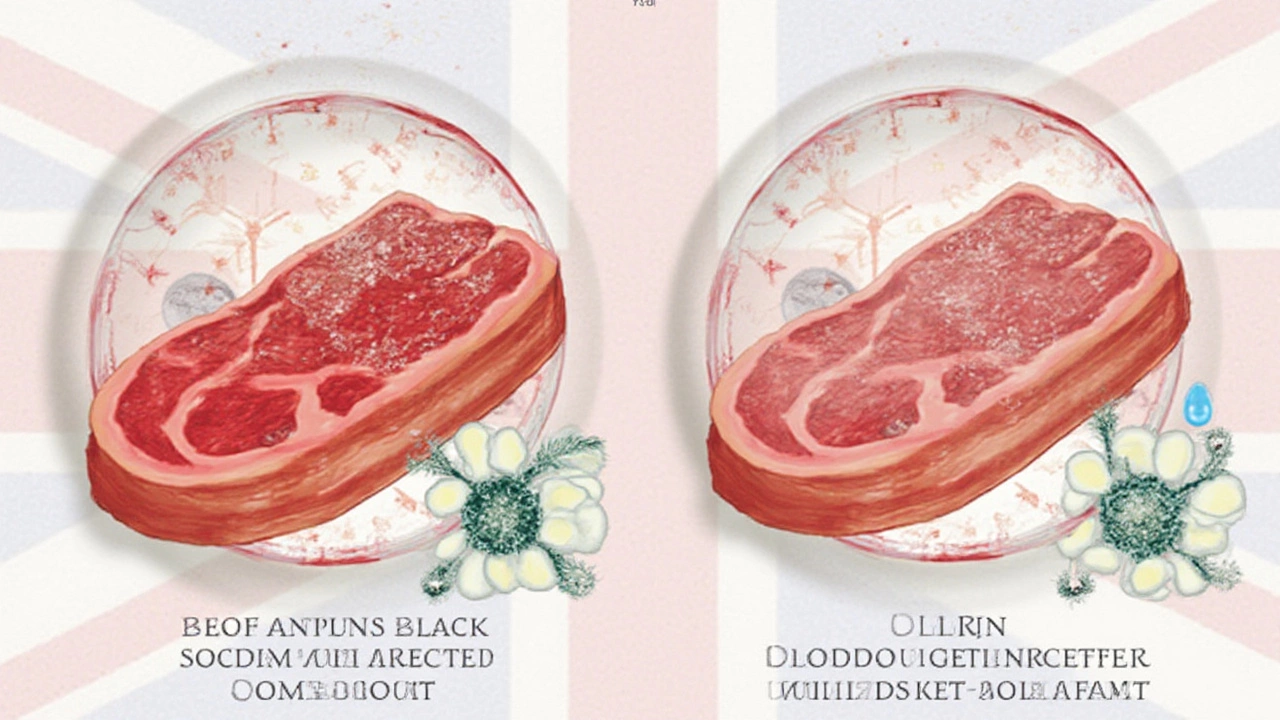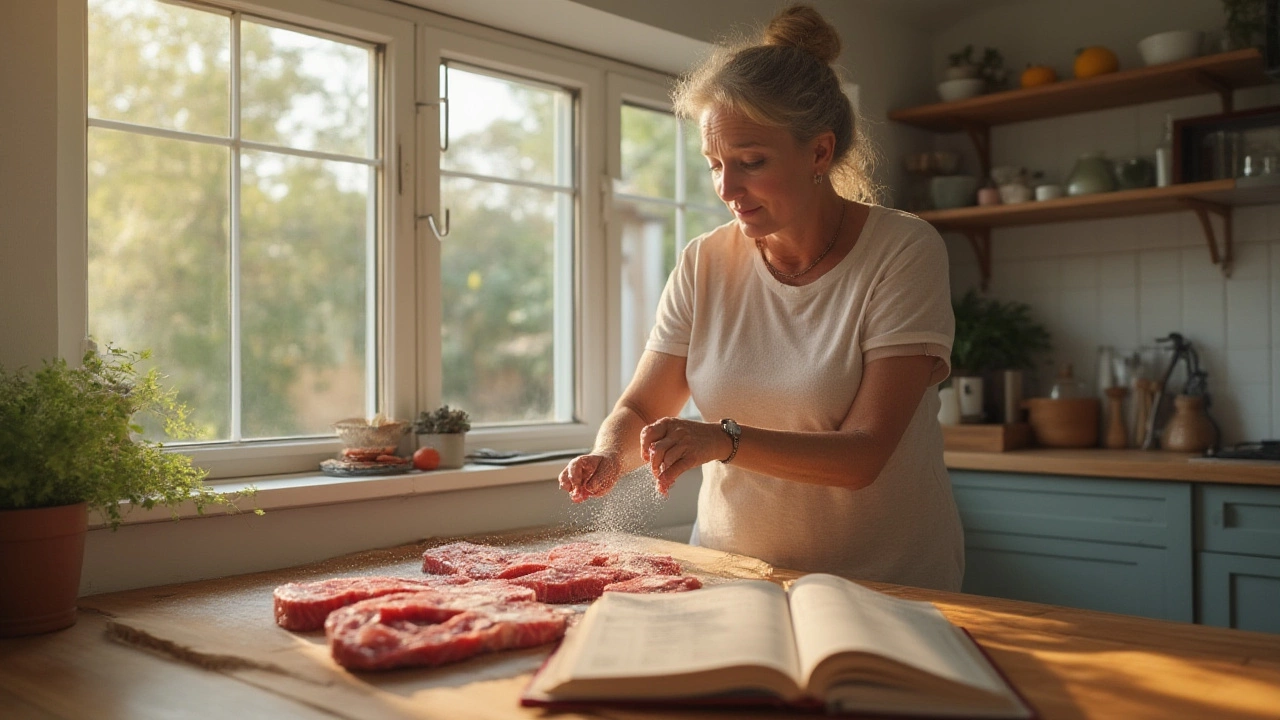Imagine hosting a barbecue and marinating steaks with baking soda for that magical tenderness—but you accidentally forget to rinse them before throwing them on the grill. As soon as those steaks hit the heat, something feels off. The smell is a little strange, the surface looks kind of powdery, and your dog Biscuit is probably the only one who still thinks dinner smells good. Now you’re stuck wondering: is everyone about to get a mouthful of salty, metallic meat, or is it actually harmful?
Why People Use Baking Soda to Tenderize Meat
Baking soda (sodium bicarbonate) has been a kitchen hack for generations. The science is straightforward: baking soda raises the pH on the meat’s surface, tricking proteins into holding onto water and loosening their bond—which basically keeps the meat juicy and soft. A lot of Chinese cuisine relies on this for stir-fried beef and chicken—ever wondered why takeaway always has perfectly smooth, bouncy meat? That's the baking soda trick at work.
Usually, people use a modest amount—a teaspoon or so for every 500g of meat. They sprinkle or rub it onto sliced portions and let it sit for about 15 to 30 minutes. The result? Chicken, beef, or pork that won’t turn into chewing-gum after cooking. Even big names like Kenji López-Alt from Serious Eats have sung its praises after plenty of side-by-side steak tests. But here’s the catch: baking soda isn’t a flavor, and you’re not supposed to eat it straight up. It does its job, but then you’re expected to rinse the meat well to wash away that unpleasant residue. If you don’t, you might get more than you bargained for at dinner.
The Aftermath of Not Rinsing Off Baking Soda
So, what’s the big deal if you forget to rinse? For starters, the taste is the first red flag. Baking soda left on the surface will give meat a sharp, soapy, or metallic flavor. Even a little goes a long way, and most folks (unless you’re Biscuit, who’ll eat anything) don’t find that appetizing. Some people have compared the flavor to biting into a cheap antacid tablet—definitely not what you’re after when you grill a nice lamb chop.
Texture-wise, things get weird too. Meat that isn’t rinsed might look chalky or feel slimy, which isn’t exactly top-chef quality. That powdery look? That’s just leftover soda clinging on for dear life, refusing to dissolve during the cooking process—especially if you’re searing or grilling, since direct heat dries the residue quickly. Try frying a piece of chicken breast coated in baking soda; the end result might remind you of science fair volcanoes—bubbly and puffy at the edges—because the soda reacts with heat, releasing carbon dioxide.
Let’s talk about health and digestion for a sec. If you consume a small amount of unrinsed baking soda by accident, you’re probably fine—especially if you have healthy kidneys. Your body naturally produces and filters out sodium bicarbonate every day. But if you become a repeat offender, eating large amounts regularly, you may experience indigestion, an upset stomach, or even mild nausea. For people with high blood pressure or kidney disease, the sodium content could add up fast. Here’s a peek at the sodium numbers in baking soda meat compared to standard salt, per teaspoon:
| Substance | Sodium per tsp |
|---|---|
| Baking Soda (sodium bicarbonate) | 1250 mg |
| Table Salt (sodium chloride) | 2325 mg |
Surprisingly, baking soda isn’t quite as salty as table salt by weight, but it’s not negligible. And regardless of sodium levels, it just doesn’t taste right if it’s not rinsed off.

How to Use Baking Soda for Perfectly Tender Meat
Getting the baking soda trick right is way less stressful than it sounds. The process goes like this:
- Pat the meat dry so the soda sticks and doesn’t just run off the surface.
- Sprinkle about 1 teaspoon of baking soda per 500g/1lb of meat. (If you're working with steaks or larger cuts, stick to lightly coating the surface.)
- Rub it in gently, or toss cut strips in a bowl to coat evenly.
- Let it rest for 15-30 minutes—don’t leave it for hours, or you’ll risk mushy texture.
- Rinse under plenty of cold running water. Don’t just let a trickle hit it—actually massage the pieces with your fingers to wash away all the soda.
- Pat dry again with paper towels, then cook as you like. Whether it’s grilling, frying, or stir-frying, the meat should now be both tender and soda-free.
A lot of folks make the mistake of skipping that last rinse, especially if they’re distracted by a barking dog chasing local birds in the backyard (not naming any names, Biscuit). The rinse stage is so important because even a light coating left behind can mess up the flavor of your dish. Some TikTok chefs suggest using a colander and massaging each piece thoroughly. For big steaks, I just hold them under a strong, cold tap and give them a rub to be safe.
After rinsing, you can marinate as usual or season with salt (since you rinsed away any residual sodium), remembering not to go overboard.
The Science and Safety Behind Proper Rinsing
Baking soda is a straightforward compound: NaHCO3, or sodium bicarbonate. It’s an effective tenderizer precisely because it interferes with the chemical bonds in muscle tissue. Yet left unrinsed, the residue on the meat creates a pH shift that lingers—not just in the flavor but also in your stomach. High-alkaline foods aren’t dangerous in small doses, but they can upset delicate digestive systems if you’re not expecting it. One test kitchen study from New Zealand’s own Consumer magazine found that even after only 20 minutes, a rinsed chicken breast compared to an unrinsed one was like night and day—moist, pleasant chicken versus rubbery, bitter-tasting mystery meat.
For people with sodium-restricted diets or conditions like hypertension, the risk isn’t likely from a one-off BBQ mistake. But if you’re the kind who meal-preps by treating a week’s worth of chicken with baking soda and skips rinsing, the sodium could pile up quickly. Excess sodium means fluid retention, possible headaches, or increased blood pressure—a lousy tradeoff for a shortcut gone wrong.
If you find yourself in a situation where you accidentally cooked without rinsing, don’t panic. Eating a small portion won’t hurt most healthy adults. Just watch the portion size, and maybe chase it with an extra glass of water. And if someone at the table says, “Does this taste a bit... off?” just confess and send Biscuit in as backup for leftovers. But for next time, remember: the rinse is your last line of defense for both taste and health.
